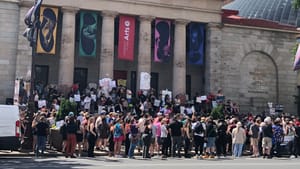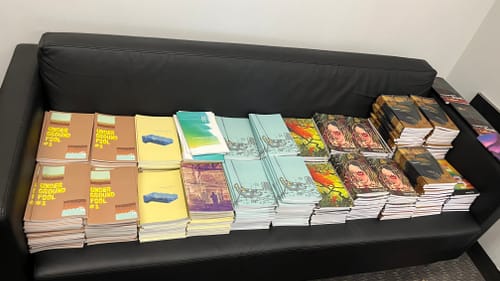Stay in the Loop
BSR publishes on a weekly schedule, with an email newsletter every Wednesday and Thursday morning. There’s no paywall, and subscribing is always free.
Students and faculty pledge to keep creating despite their school’s "unconscionable" demise
A University of the Arts professor speaks: “Knowing it’s the last time I’ll be here is unbearable.”

It’s Monday, June 3, and I’m walking to my office on the eighth floor of Terra Hall. Over the years, my students have been amused by its smallness. To me, it’s always felt cozy. I like the window, which looks across Broad Street into the Bellevue. I like the one purple wall. This afternoon, I unlock the door, as I have countless times, but can’t bring myself to go inside.
I shouldn’t have been back on campus until August. The spring semester ended 17 days earlier. Fifteen days earlier, at commencement, university president Kerry Walk and board chairman Jud Aaron delivered affirming, forward-looking speeches. Three days earlier, I was bringing my nine-year-old home from swimming lessons when I saw the headline—as did hundreds of other faculty, staff, and students, caught off-guard in the middle of their ordinary Friday evenings—something, absurdly, about the university closing in one week. I phoned my colleague and said: “Is this real?”
No warning, no explanation
The closure of the University of the Arts—about which faculty and staff were given no warning and, as of this writing, no explanation—has made national headlines for its abruptness and unconscionable mishandling. On Monday, June 3, I’ve come to pack up my office. As I stare around the room, I start shaking involuntarily, wondering what to take.
I taught at the University of the Arts for 24 years. The prospect of sifting through the layers is overwhelming, like packing up a room in one’s home. It helps that my friends Steven and Rahul are down the hall; we planned to do this together. But knowing it’s the last time I’ll be here is unbearable. Quickly, messily, I start dismantling the shelves, tearing through the piles. Stories from fiction workshops. Flyers from student readings. Copies of the literary magazine. Books by colleagues, alumni. A poster a class made when my book came out and they threw me a surprise party. The proposal for our BFA in creative writing. Artwork by students. All the years. All the people I’ve loved. Trembling, I grab what I think I may want, toss it in a few boxes, dump the rest. Then I come upon a college-ruled notepad, and I pause, recognizing the scrawled notes.
“There must still be a way to leave a mark”
I can see it in my mind’s eye: about 10 students around a table on Terra’s 11th floor. It would have been 2010. We didn’t yet have a creative writing program; these were students from screenwriting, animation, illustration, film. They gathered at night, after classes. They wanted to start a lit mag. We were brainstorming ideas.
I stare at the long-ago comments I scribbled as students spit-balled about the magazine and its mission: something that spoke to all students, they said. Something they had in common. On the list: Insomnia. Mustaches. Bikes. Pizza. (They were, in fairness, always being lured to campus events with pizza). The life of an artist, it says. Risky. Exhilarating. Exhausting. Brave. Then: A place that connects us. Gershman pool.
The pool was in the basement of the Gershman building at the corner of Broad and Pine, part of the original Gershman Y. By 2010, it was an empty basin, drenched in colorful graffiti. A one-time hangout for students, all students. The magazine was christened Underground Pool.
Over the years, the publication would grow more refined with the help of graphic design and illustration. During commencement—again, incredibly, less than three weeks ago—Walk mentioned it onstage, praising student work. (Today, June 3, at 4pm, Walk is scheduled to address the university at a virtual town hall. It will be canceled at 3:49pm.)

I pick up the inaugural issue, scrappy in look and feeling. The mission statement was written by the editor, a screenwriter named Dan. He describes the pool, a pile of rubble, a place students once gathered. Now, though, they’ve nailed shut the doors, he wrote. The elevator doesn’t even go to the basement anymore. The lines feel eerily prescient. However, he went on, there must still be a way to leave a mark … something still tangible, still permanent.
Crushing sadness
I find myself tearing up, then hear voices in the hallway. Students, offering to help. This is and always has been UArts students: as talented as they are kind.
“Take anything you want,” I say, gesturing around the office, which looks like it’s been ransacked. They carry my boxes down the hallway and we pile onto the elevator one last time. In the lobby, they hug me, say they’re sorry, offer to stay until I pull my car around. I hold it together—still, in front of students, feeling like a teacher—tell them I’ll be okay. But when I return and start hauling boxes to my trunk, my legs turn to sand. The sadness is crushing. A woman walking toward Terra drops her things in the doorway and, without a word, helps me with the rest. When my trunk is packed, we introduce ourselves. She teaches dance. We’ve never met. It’s when she hugs me in the middle of Broad Street that I finally start crying. “Let it out,” she says.
Remarkable, but not surprising
That night, among the many messages I’m too depleted to respond to, I get an email from one of my students, Owen, who helped that afternoon. In it, a note of something like exhilaration. After I left, he reports, he and another student, Andrew, wheeled a cart of old Underground Pools to Hamilton Hall, where students have been demonstrating. The magazines were gone in minutes. They returned to Terra for another cartful. By Tuesday, they’re mobilizing classmates to put out one final issue: a way to come together, vent, commemorate, prove their strength.

It’s a remarkable show of resilience. It’s also not surprising. All week long, these acts of creation have been happening as students, faculty, staff, alumni channel their sadness and outrage into protest and celebration. This, too, is attracting headlines: the irrepressible spirit of this place. It’s not a community that will go quietly, despite the fact that when faculty and staff are finally addressed directly, on Friday, June 7, it will be in a webinar conducted by two faces from a consulting firm, approximately 10 minutes of scripted text and staged, somber pauses, during which no one can ask questions or speak.
But the creating will continue. At Hamilton Hall, the sidewalk has become a stage. Students perform joyful music, energetic dances. Faculty and city leaders deliver eloquent speeches. The building has become an artist’s canvas. As our 150-year-old institution is casually destroyed, this community will keep creating. Respond to callousness with compassion and togetherness. Take what we cannot control and transform it, use it, let it out, push back, move forward. Be brave. Be better than those who failed us. Leave a mark, something tangible and permanent, even after they’ve nailed shut the doors.
Editor’s note: Under editor Dan Rottenberg and colleagues, Broad Street Review was originally founded out of the University of the Arts in 2005.
Sign up for our newsletter
All of the week's new articles, all in one place. Sign up for the free weekly BSR newsletters, and don't miss a conversation.

 Elise Juska
Elise Juska